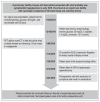Primary Functioning Neuroendocrine Tumor of the Appendix with Hypoglycemia Syndrome: A Case Report and Review of Neuroendocrine Tumors
- PMID: 32240090
- PMCID: PMC7089596
- DOI: 10.7812/TPP/19.142
Primary Functioning Neuroendocrine Tumor of the Appendix with Hypoglycemia Syndrome: A Case Report and Review of Neuroendocrine Tumors
Abstract
Introduction: Primary neuroendocrine tumors (NETs) of the appendix are uncommon, but when present are usually not hyperfunctioning. This case represents an extraordinarily rare primary hyperfunctioning NET of the appendix with a clinical presentation of symptomatic hypoglycemia in an otherwise healthy man.
Case presentation: A previously healthy 34-year-old man was found to be symptomatically hypoglycemic in early 2018. After the workup, the apparent explanation was a tumor in his midappendix, for which he was referred to our surgical oncology service for resection. The patient's clinical course is described in detail, including imaging, as well as surgical and pathologic descriptions of the appendiceal NET.
Discussion: A literature review demonstrates no other case series or reports of a primary hyperfunctioning NET of the appendix presenting with hypoglycemic crisis. The symptoms of tumor-induced hypoglycemia more typically arise with islet cell tumors, such as pancreatic NETs or insulinomas. We believe this case represents a nonislet cell tumor-induced hypoglycemia. This patient's elevated serum proinsulin level preoperatively implies secretion of proinsulin by the tumor. However, tumor-induced hypoglycemia caused by proinsulin has been described previously only in pancreatic tumors. This unique case adds knowledge to the possible glycemic endocrine effects of nonpancreatic NETs, specifically those that arise primarily in the appendix.
Conflict of interest statement
The author(s) have no conflicts of interest to disclose.
Figures






Similar articles
-
[Neuroendocrine tumors of the appendix].Rev Med Liege. 2009 Jul-Aug;64(7-8):361-5. Rev Med Liege. 2009. PMID: 19777911 French.
-
Single-incision laparoscopic ileocecal resection in a 10-year-old child with appendiceal neuroendocrine tumor.World J Surg Oncol. 2019 Nov 26;17(1):197. doi: 10.1186/s12957-019-1745-y. World J Surg Oncol. 2019. PMID: 31771590 Free PMC article.
-
The Clinicopathological Significance of Tumor Cell Subtyping in Appendiceal Neuroendocrine Tumors: A Series of 135 Tumors.Endocr Pathol. 2024 Jun;35(2):107-112. doi: 10.1007/s12022-024-09813-4. Epub 2024 Jun 4. Endocr Pathol. 2024. PMID: 38833137 Free PMC article.
-
[Neuroendocrine tumours of the appendix].Vnitr Lek. 2009 Nov;55(11):1051-5. Vnitr Lek. 2009. PMID: 20017436 Review. Czech.
-
Neuroendocrine Neoplasms of the Appendix: A Review of the Literature.Anticancer Res. 2018 Feb;38(2):601-611. doi: 10.21873/anticanres.12264. Anticancer Res. 2018. PMID: 29374682 Review.
References
-
- Garcia-Carbonero R, Capdevila J, Crespo-Herrero G, et al. Incidence, patterns of care and prognostic factors for outcome of gastroenteropancreatic neuroendocrine tumors (GEP-NETs): Results from the National Cancer Registry of Spain (RGETNE) Ann Oncol. 2010 Sep;21(9):1794–803. doi: 10.1093/annonc/mdq022. - DOI - PubMed
Publication types
MeSH terms
LinkOut - more resources
Full Text Sources
Medical

